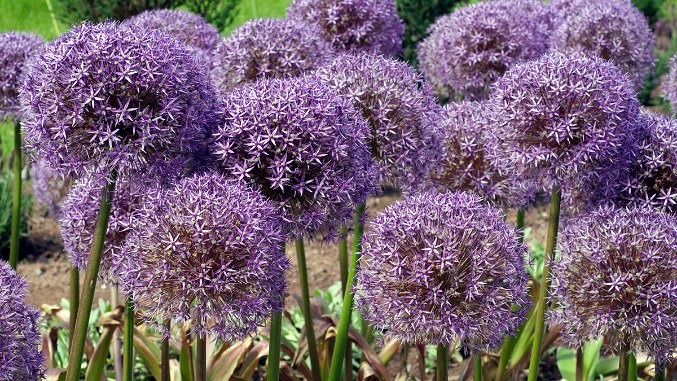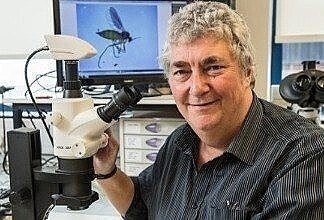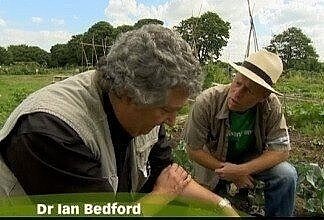
Protect your alliums from the allium leaf miner fly
3 Minute Read
Dr Ian Bedford tells us everything we need to know about the 'bug of the month' for February, the allium leaf miner fly.Allium is a genus of flowering monocot plants that are commonly referred to as the onion genus and it includes many common vegetables such as onion, shallot, leek, and garlic. These edibles are not only commercially produced crops but are popular homegrown foods too.
Over the past two decades commercial, and homegrown alliums across Britain have been suffering problems from an invasive plant pest, known as Phytomyza gymnostoma, the allium leaf miner fly. This fly was first recorded in Britain in 2003 on onions in an East Midlands garden and has since become widespread across most of England and Wales.
Over the past two decades commercial, and homegrown alliums across Britain have been suffering problems from an invasive plant pest, known as Phytomyza gymnostoma, the allium leaf miner fly. This fly was first recorded in Britain in 2003 on onions in an East Midlands garden and has since become widespread across most of England and Wales.
What is the allium leaf miner fly?
The allium leaf miner fly is thought to have come from mainland Europe where it had first been recognised as a serious crop pest in Poland in the 1950’s, before steadily spreading to all other countries where alliums were grown.An infestation of allium leaf miners starts when the small 3mm long, greyish brown adults hatch from underground pupae and mate. Attracted by the chemical volatiles that alliums emit, the females land on the plant’s leaf blades and begin puncturing them at the base with the rear of their abdomen. Feeding on sap within some of the puncture holes, the females will lay their eggs into others.
After a few days, the eggs hatch into white maggots that tunnel down inside the plant, devouring the tissue as they go and often leaving distinctive white lines down the foliage. As the maggots continue to feed and grow, the damage they cause inside the plants will become more extensive, often allowing fungal rots to establish that can cause the plant to wilt and die.
When fully mature, the maggots will change into cylindrical, dark brown pupae amongst the decaying plant tissue or in the surrounding soil. The adult flies will then either hatch in the spring if they are the first generation of the year, or during mid to late autumn if they are the second generation (whose progeny then pupate and overwinter again).

Controlling the allium leaf miner fly
Controlling the allium leaf miner fly is not possible if the infestation has already become established within the plant unless the egg-laying sites can be identified and removed at a very early stage. Once the maggots have tunnelled deeper into the tissue, the only real option would be to identify, remove, and destroy the affected plants.Protecting alliums from the Allium leaf miner fly is however a possibility if the egg-laying females can be prevented from accessing the plants in the first place. To achieve this, alliums will have to be planted or sown in a location where leaf-mining flies haven’t previously occurred, just in case viable pupae are still within the soil.
A barrier of fine mesh netting (0.6 – 0.8 sq. mm), or non-woven horticultural fleece will then need to be securely positioned over the plants, ensuring that there are no gaps around the edges. It’s also worthwhile removing all allium plants that remain from the previous crop during the winter months and regularly hoeing through the top few cm of soil where they had grown. This should expose any overwintering pupae to frosts and insectivorous birds and so reduce the number of adult flies that emerge in the spring.

About Dr Ian Bedford
Ian has been fascinated by the bug world for as long as he can remember. From studying butterflies on the South Downs as a youngster, he went on to pursue a career in Research Entomology and ran the Entomology Dept at the John Innes Centre in Norwich up until his recent retirement.VISIT WEBSITE

'Bug of the month'
Visit our 'bug of the month' archive. Every month Ian will share his knowledge on how to protect your plants and gardens from preventable pest invasions while providing valuable insights into the insects regularly found in our gardens.
find out more
Comments (0)
Why not be the first to send us your thoughts?
Leave A Comment
Most popular articles
1
Plastic plant pots dimensions and uses2
Peat vs Peat Free - Choosing the right Potting Compost3
How to Grow Watercress at home in plant pots4
January Jobs5
Our guide to seed sowing compost